20 Truly Amazing Natural Attractions In Iran
A Journey Through Iran's Top Stunning Natural Wonders

Iran Nature showcases a plethora of stunning natural attractions across its diverse landscape. The majestic Mount Damavand, serene Turkmen Sahra, vast Lut Desert, enchanting Qeshm Island, and mystical Maranjab Desert stand out as captivating highlights.
In addition to exploring beautiful mosques and ancient ruins, tourists can immerse themselves in the spectacular and varied scenery of Iran nature.
This untouched and inspiring natural heritage includes breathtaking mountains, sprawling deserts, verdant forests, and intriguing caves, all demonstrating the richness of Iran nature.
This guide introduces you to the top natural attractions in Iran, providing essential information for nature enthusiasts embarking on their travels.
Contents
1. Mount Damavand
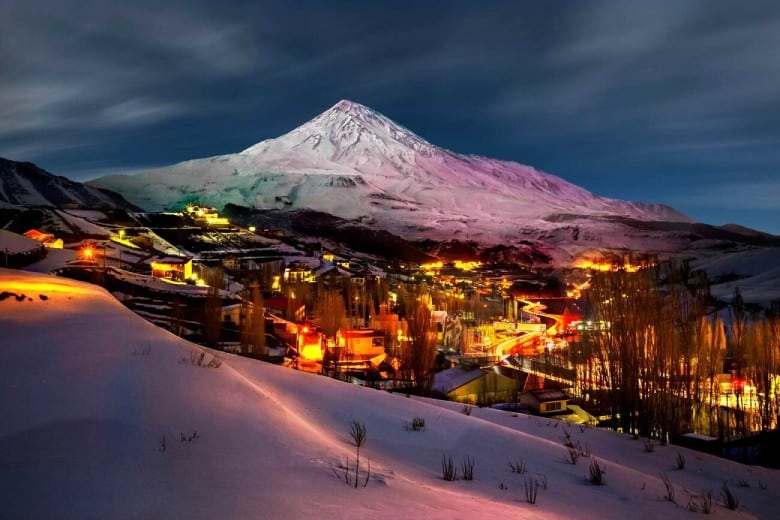
Mount Damavand, standing as a majestic beacon in the Tehran Province, is not just a mountain; it’s a legendary symbol woven into Iranian folklore and poetry. Dominating the landscape as the highest peak in Iran and the Middle East, this potentially active volcano reaches a staggering height of 5,610 meters. Its snowy summit, often cloud-kissed, offers breathtaking views that have captivated adventurers and poets alike.
Historically, Mount Damavand has been revered, featuring prominently in Persian mythology. It’s known not just for its geological significance but also as a source of inspiration in Persian literature. Since its first recorded ascent in the 1830s, the mountain has drawn hikers, climbers, and nature enthusiasts from around the world.
FUN FACT: Mount Damavand is the highest volcanic peak in Asia and a part of the Volcanic Seven Summits climbing challenge.
KNOW BEFORE YOU GO: The climbing season typically runs from June to September. The mountain is accessible from Tehran, with the base camps reachable by car.
WHEN TO VISIT: The best time for climbing is during the summer months, from June to September, when the weather is most favorable.
GATEWAY CITY: Tehran
2. Lut Desert
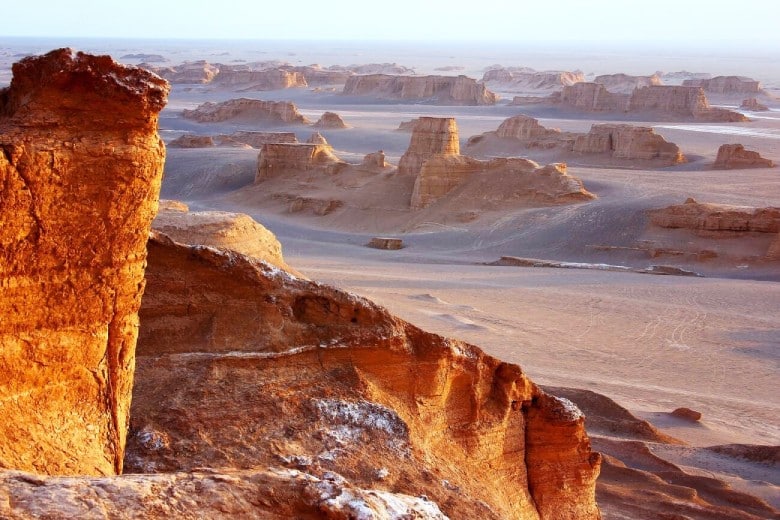
Lut Desert, located in Iran’s southeastern Kerman Province, is a spectacular natural wonder that has captured the fascination of travelers and scientists alike. Known locally as Dasht-e Lut, this desert holds the record for having some of the highest surface temperatures ever recorded on Earth. Its vast, sun-scorched landscape spans about 51,800 square kilometers, making it one of the largest deserts in Iran.
The Lut Desert is famous for its extraordinary formations, including salt plains, sand dunes, and the distinctive kaluts – yardang rock formations shaped by the relentless force of wind erosion. These natural sculptures create an almost Martian landscape, offering a surreal and otherworldly experience to visitors. The desert’s unique ecosystem also supports a range of wildlife adapted to the harsh environment.
FUN FACT: The Lut Desert was the first natural UNESCO World Heritage site in Iran, recognized for its exceptional and dramatic landscapes.
KNOW BEFORE YOU GO: The desert is accessible via Kerman city. Travelers are advised to visit with guided tours due to the extreme and challenging conditions.
WHEN TO VISIT: The best time to explore the Lut Desert is from October to March when temperatures are milder.
GATEWAY CITY: Kerman
3. Qeshm Island
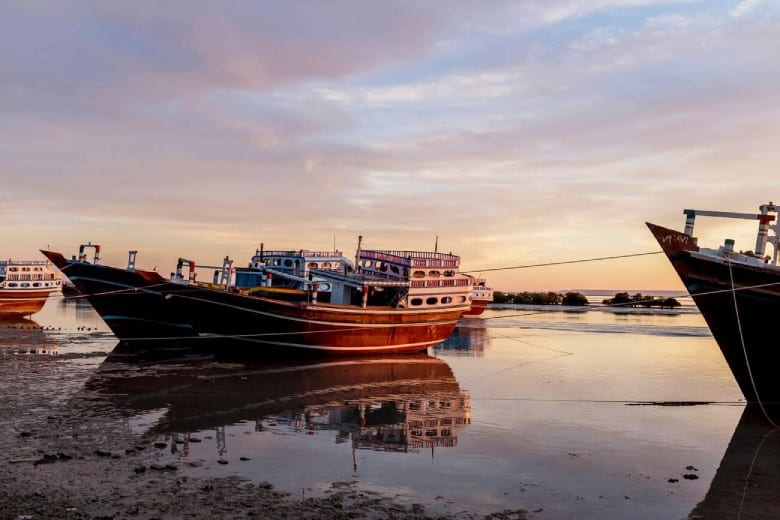
Qeshm Island, the largest island in the Persian Gulf, is nestled in the Hormozgan Province of Iran. This island stands out not only for its size but also for its unique geological formations, rich history, and distinct culture. Spanning an area of approximately 1,491 square kilometers, Qeshm offers a blend of untouched nature and cultural richness.
The island is renowned for its natural attractions, including the Hara marine forests, the enigmatic Valley of Stars shaped by wind and water erosion, and the stunning Chahkooh Canyon. Qeshm is also home to a diverse range of wildlife, particularly birds, making it a haven for nature enthusiasts and birdwatchers.
FUN FACT: Qeshm Island is known for its unique mangrove forests, locally known as ‘Hara forests‘, which are among the most significant mangrove ecosystems in the Persian Gulf.
KNOW BEFORE YOU GO: Qeshm is accessible by ferry from Bandar Abbas. The island is visa-free for most nationalities, making it a convenient destination for international travelers.
WHEN TO VISIT: The best time to visit Qeshm Island is from late autumn to early spring, when the weather is cooler and more pleasant.
GATEWAY CITY: Bandar Abbas
4. Jangal-e Abr (Cloud Forest)
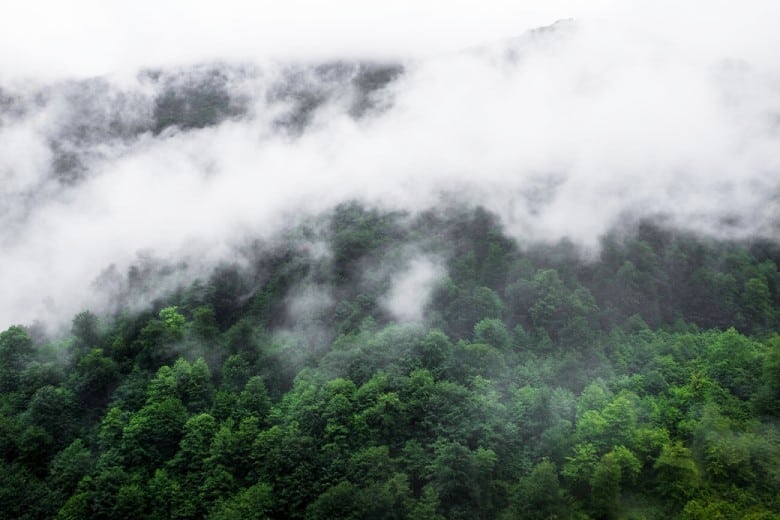
Jangal-e Abr, also known as the Cloud Forest, is one of Iran’s most enchanting natural treasures, situated in the Semnan Province. This unique forest is a rare natural phenomenon where dense forests meet cloud-covered mountaintops, creating an ethereal and mystical landscape. The forest covers an area of approximately 35,000 hectares and sits at an altitude of 2,200 meters above sea level.
What sets Jangal-e Abr apart is its frequent envelopment in a sea of clouds, a result of the convergence of humid Caspian air with the drier Iranian plateau. This natural occurrence gives the forest its dreamlike quality, with trees emerging from a blanket of clouds. The forest is a biodiversity hotspot, home to a variety of flora and fauna, making it a paradise for nature lovers and environmental enthusiasts.
FUN FACT: Jangal-e Abr is one of the few remaining cloud forests in the world, offering a unique ecosystem where the forest seems to float in the clouds.
KNOW BEFORE YOU GO: The forest is best accessed from the city of Shahroud. It’s essential to visit with a guide as the terrain can be challenging to navigate.
WHEN TO VISIT: The best time to visit Jangal-e Abr is from spring to early autumn, with the cloud phenomenon most prevalent from late spring to late summer.
GATEWAY CITY: Shahroud
5. Alisadr Cave
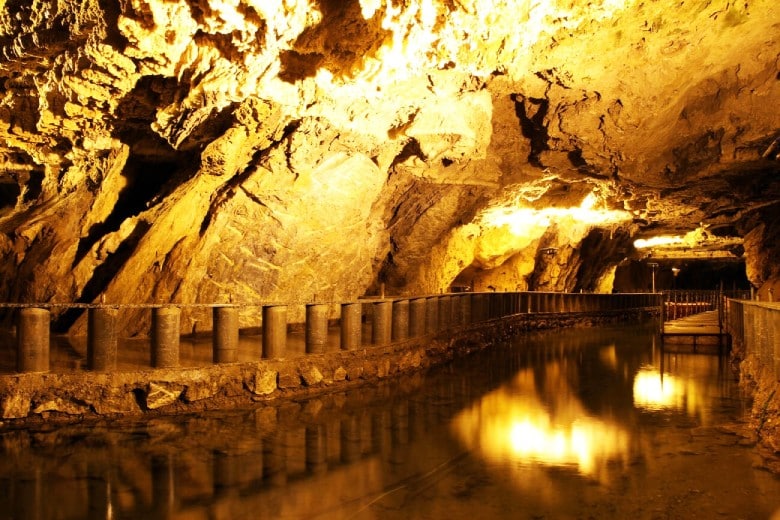
Alisadr Cave in Hamadan Province is a hidden jewel of Iran, inviting visitors to an underground world of wonder. Known as one of the world’s most magnificent water caves, Alisadr offers an extraordinary journey through its ancient, water-filled passageways. The cave system, which stretches for several kilometers, is renowned for its large, serene subterranean lake and the stunning rock formations that adorn its interior.
This natural wonder, believed to be millions of years old, is not only a geological marvel but also a significant archaeological site. Evidence suggests that the cave was known to humans as early as 12,000 years ago. The calm waters of the cave’s lake reflect the intricate stalactites and stalagmites, creating a mesmerizing, mirror-like effect.
FUN FACT: Alisadr Cave is unique for its extensive waterways, allowing visitors to explore its beauty on boat tours, a rare experience for a cave of this size.
KNOW BEFORE YOU GO: The cave is located near the city of Hamadan. Visitors should wear comfortable shoes and bring a light jacket, as the cave temperature is cooler than the outside.
WHEN TO VISIT: Alisadr Cave is open year-round, but the best time to visit is from late spring to early autumn for the most pleasant weather conditions.
GATEWAY CITY: Hamadan
6. Miankaleh Peninsula
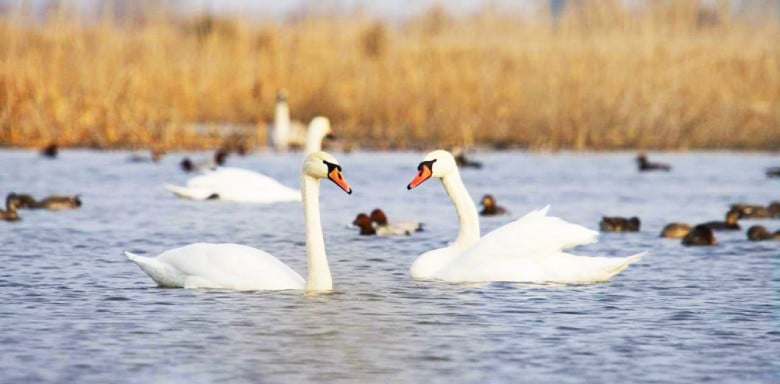
Miankaleh Peninsula, situated in the Mazandaran Province in northern Iran, is a remarkable and unique natural wonder. This narrow peninsula extends like a slender finger into the Caspian Sea, creating a rich and diverse ecosystem. It’s recognized as one of the most important wildlife refuges in the Middle East, offering a haven for a wide array of bird species, especially migratory birds.
The peninsula, stretching approximately 48 kilometers in length and varying between 1.3 to 3.2 kilometers in width, is a blend of sandy shores, lush wetlands, and dense forests. It’s home to a variety of ecosystems, including salt marshes, freshwater ponds, and tidal flats. Miankaleh has been designated as a Ramsar site, indicating its global importance as a wetland habitat.
FUN FACT: The Miankaleh Peninsula is often referred to as the birdwatchers’ paradise, with over 250 bird species recorded, including flamingos, pelicans, and swans.
KNOW BEFORE YOU GO: Access to Miankaleh is typically through the town of Behshahr. Visitors are encouraged to respect the fragile ecosystem and to observe wildlife responsibly.
WHEN TO VISIT: The best time to visit Miankaleh is from late autumn to early spring, which aligns with the bird migration season.
GATEWAY CITY: Behshahr
7. Raghaz Canyon
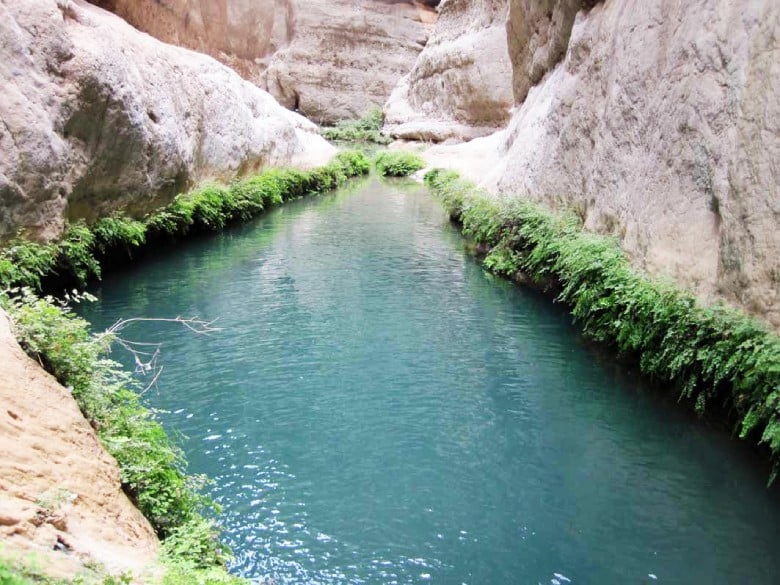
Raghaz Canyon, located in the picturesque Fars Province of Iran, is a hidden gem waiting to be discovered. This stunning canyon, often considered one of Iran’s most beautiful natural attractions, offers a dramatic landscape filled with cascading waterfalls, deep pools, and rugged rock formations. The canyon, carved over millennia by the relentless flow of the Raghez River, presents a breathtaking blend of natural beauty and geological wonder.
The area surrounding Raghaz Canyon is rich in biodiversity, hosting a variety of plant and animal life. The canyon itself is about 200 meters long and is known for its series of thirty waterfalls and more than 100 natural pools, creating a paradise for adventure enthusiasts and nature lovers.
FUN FACT: Raghaz Canyon is often referred to as the “Land of a Hundred Waterfalls,” due to its numerous cascading waterfalls, making it a spectacular sight, especially in the spring.
KNOW BEFORE YOU GO: The canyon is best accessed from the city of Darab. It’s recommended to visit with a guide as the terrain can be challenging and requires some hiking and climbing.
WHEN TO VISIT: The ideal time to visit Raghaz Canyon is from late winter to early summer when the water levels are high, and the landscape is lush and green.
GATEWAY CITY: Darab
8. Rainbow Mountains (Aladaglar Mountains)
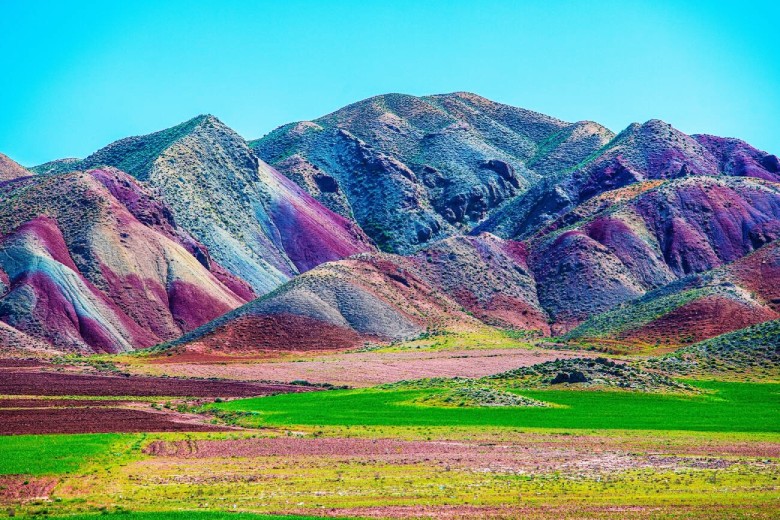
Rainbow Mountains, also known as Aladaglar Mountains, are a spectacular natural phenomenon located in Iran’s East Azerbaijan Province. This geological wonder is renowned for its vibrant and colorful sedimentary rock formations, displaying a breathtaking array of hues from reds and oranges to yellows and greens. These unique colors are the result of various mineral deposits that have formed over millions of years.
The Aladaglar Mountains stretch across a vast area, offering a striking contrast to the surrounding landscape. The vivid striations and patterns in the rock create a mesmerizing visual effect, drawing photographers, geologists, and nature enthusiasts from around the world.
FUN FACT: The Rainbow Mountains are often compared to a painter’s palette due to their diverse and vivid colors, making them a natural masterpiece.
KNOW BEFORE YOU GO: The mountains are accessible from the city of Tabriz. A trip to the Rainbow Mountains can be combined with a visit to other natural and historical sites in the region.
WHEN TO VISIT: The best time to see the Rainbow Mountains in all their glory is from late spring to early autumn, when the sunlight enhances their colors.
GATEWAY CITY: Tabriz
9. Badab-e Surt Springs
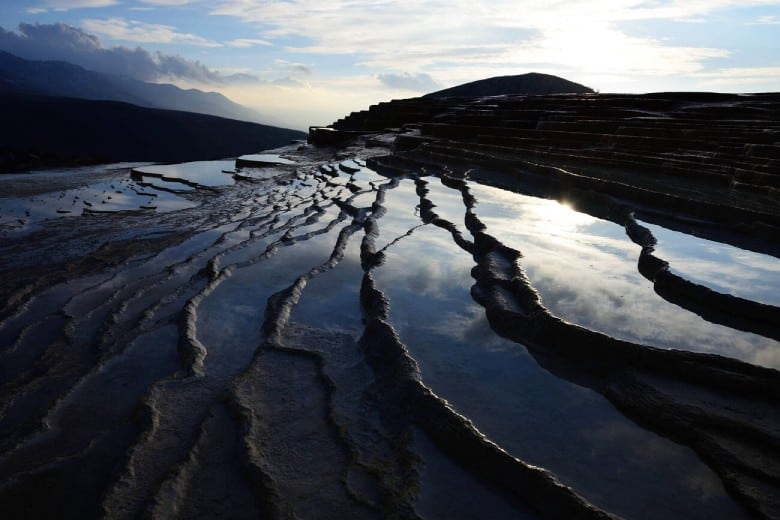
Badab-e Surt Springs in Mazandaran Province is a stunning natural wonder, showcasing one of Iran’s most unique and picturesque landscapes. These terraced springs are a rare geological formation, created over thousands of years by mineral-laden water flowing from two distinct mineral springs. The springs have deposited layers of travertine, a form of limestone, creating a series of beautiful, naturally terraced pools.
The site features two main types of springs: one with salty water believed to have medicinal properties and the other with orange-colored water rich in iron oxide. The vibrant colors of these terraces, ranging from shades of orange to red, create a visually captivating scene, especially at sunrise and sunset.
FUN FACT: Badab-e Surt is often compared to Turkey’s famous Pamukkale, yet it remains one of Iran’s lesser-known treasures.
KNOW BEFORE YOU GO: The springs are located near the village of Orost. Visitors should wear comfortable walking shoes and be prepared for a short hike to reach the site.
WHEN TO VISIT: The best time to visit Badab-e Surt Springs is during spring and autumn, as the milder weather conditions make the hike more enjoyable.
GATEWAY CITY: Sari
10. Masal Village
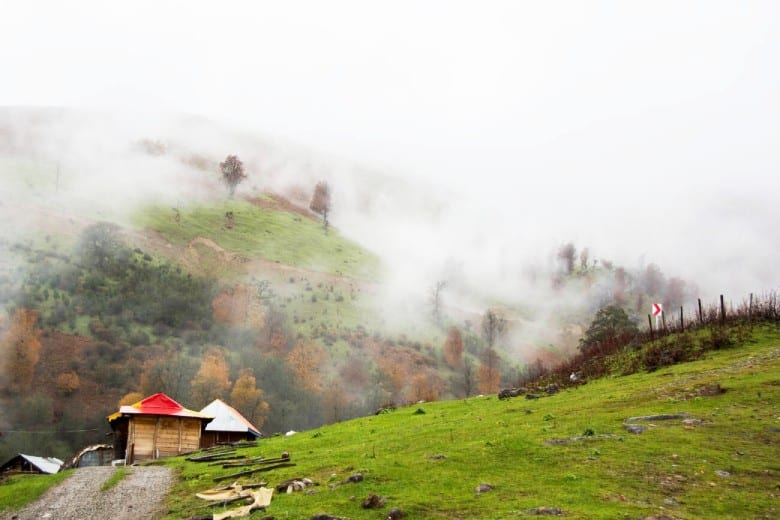
Masal Village in Gilan Province is a serene and picturesque destination, often regarded as a hidden gem in the lush green landscape of northern Iran. This quaint village, nestled in the Alborz mountain range, is known for its breathtaking natural beauty and tranquil atmosphere. Surrounded by dense forests, rolling hills, and tea plantations, Masal offers a peaceful retreat from the hustle and bustle of city life.
The village is famous for its traditional wooden architecture and the stunning vistas of the surrounding countryside. The nearby Olasbelangah mountain area is particularly renowned for its cloudscape views, where the village seems to float above the clouds, especially in the mornings and after rainfall.
FUN FACT: Masal is often referred to as the “Lost Paradise” due to its unspoiled natural beauty and dreamy cloud-covered landscapes.
KNOW BEFORE YOU GO: Masal is accessible from the city of Rasht. The village and its surroundings are ideal for hiking, photography, and enjoying the local culture and cuisine.
WHEN TO VISIT: The best time to visit Masal Village is from late spring to early autumn, when the weather is pleasant, and the natural scenery is at its most vibrant.
GATEWAY CITY: Rasht
11. Pink Lake (Maharlu Salt Lake)

Pink Lake, also known as Maharlu Salt Lake, is a striking natural phenomenon located in Iran’s Fars Province. This shallow salt lake is renowned for its vibrant pink hue, a result of the interaction between sunlight, algae, and the high concentration of minerals in the water. The lake covers an area of approximately 600 square kilometers and is a significant source of salt in the region.
The color of the lake varies from light pink to a more intense shade depending on the season and the amount of sunlight. This stunning color, combined with the surrounding landscapes of mountains and fields, makes it a photographer’s paradise. The lake is not only a visual spectacle but also an important habitat for migratory birds and wildlife.
FUN FACT: Maharlu Salt Lake is often compared to Australia’s famous Lake Hillier, sharing the rare and captivating characteristic of naturally pink water.
KNOW BEFORE YOU GO: The lake is located near the city of Shiraz. Visitors should be mindful of the environment and avoid disturbing the natural habitat.
WHEN TO VISIT: The best time to witness the lake’s pink color is during the late spring and summer months when the concentration of algae and minerals is highest.
GATEWAY CITY: Shiraz
12. Darak Beach

Darak Beach in Sistan and Baluchestan Province is a captivating coastal gem where the desert meets the sea. This unique beach is located at the convergence of the desert and the Oman Sea, offering a rare and picturesque landscape. The contrast of golden sand dunes rolling into azure waters creates a surreal and beautiful sight, making Darak Beach a must-visit destination for nature lovers and photographers.
This secluded beach is known for its serene environment and unspoiled natural beauty. Visitors can enjoy the tranquility of the desert while listening to the soothing sounds of sea waves. The beach also provides a perfect setting for stargazing, with clear night skies free from light pollution.
FUN FACT: Darak Beach is one of the few places in the world where the desert directly meets the ocean, creating a stunning and unusual natural phenomenon.
KNOW BEFORE YOU GO: Darak Beach is accessible from the city of Chabahar. It’s advisable to visit with a guide due to the remote location and unique terrain.
WHEN TO VISIT: The best time to visit Darak Beach is from late autumn to early spring when the weather is cooler and more comfortable for exploring the desert and coastal areas.
GATEWAY CITY: Chabahar
13. Latun Waterfall

Latun Waterfall, situated in the lush Gilan Province, stands as one of Iran’s highest and most stunning waterfalls. Cascading from a height of about 105 meters, Latun creates a spectacular sight amidst the verdant landscapes of northern Iran. This waterfall is not just a natural attraction; it’s a serene retreat that offers visitors a chance to connect with nature’s unspoiled beauty.
Nestled in the Alborz mountain range, the area around Latun Waterfall is a haven for biodiversity, boasting rich flora and fauna. The sound of the water plunging into the pool below, combined with the surrounding greenery, creates a tranquil and rejuvenating atmosphere.
FUN FACT: Latun Waterfall is a popular spot for nature lovers and photographers, especially in spring and early summer when the water flow is at its peak and the surrounding nature is in full bloom.
KNOW BEFORE YOU GO: The waterfall is accessible from the city of Astara. A short hike is required to reach the waterfall, so visitors should wear comfortable shoes and carry water.
WHEN TO VISIT: The ideal time to visit Latun Waterfall is from late spring to early summer, when the surrounding nature is lush, and the waterfall is most vibrant.
GATEWAY CITY: Astara
14. Anzali Lagoon

Anzali Lagoon, located in the beautiful Gilan Province, is a coastal wonder and an ecological treasure. This vast lagoon, one of the largest in Iran, is famous for its extensive wetlands, lush reed beds, and diverse range of birdlife. Spanning an area of around 150 square kilometers, it plays a crucial role in the regional ecosystem and supports a rich biodiversity.
This lagoon is a birdwatcher’s paradise, known for its significant populations of migratory birds, including pelicans, swans, and flamingos. The water’s surface, dotted with traditional fishing boats and framed by dense reeds, offers a picturesque and tranquil setting.
FUN FACT: Anzali Lagoon is renowned for its beautiful lotus flowers, which bloom in the summer and create a stunning and fragrant carpet of pink and white across the water.
KNOW BEFORE YOU GO: The lagoon is easily accessible from the city of Bandar-e Anzali. Visitors are encouraged to take boat tours to experience the lagoon’s beauty up close and to observe the wildlife responsibly.
WHEN TO VISIT: The best time to visit Anzali Lagoon is from late spring to early autumn, with the lotus bloom peaking in July and August.
GATEWAY CITY: Bandar-e Anzali
15. Maranjab Desert

Maranjab Desert, located in the Isfahan Province, is a captivating destination that offers an unforgettable desert experience. Known for its sprawling sand dunes, salt lakes, and historic caravanserais, this desert is a testament to the timeless beauty and harshness of Iran’s natural landscapes. Covering a vast area, Maranjab is not only a place of natural beauty but also a significant part of the Silk Road history.
The desert is renowned for its shifting sand dunes, some reaching heights of up to 50 meters. These golden dunes create a mesmerizing and ever-changing landscape. The area is also home to the Salt Lake (Darya-ye Namak), which adds a unique contrast to the sandy desert with its vast white expanses.
FUN FACT: The historic Maranjab Caravanserai, built in the Safavid era, stands as a reminder of the ancient trade routes that crossed this desert, offering a glimpse into Iran’s rich history.
KNOW BEFORE YOU GO: The desert is accessible from Kashan. Visitors are advised to explore Maranjab with a guided tour, as the desert terrain can be challenging to navigate.
WHEN TO VISIT: The best time to visit Maranjab Desert is from autumn to early spring, when the temperatures are more moderate and suitable for desert exploration.
GATEWAY CITY: Kashan
16. Mesr Desert
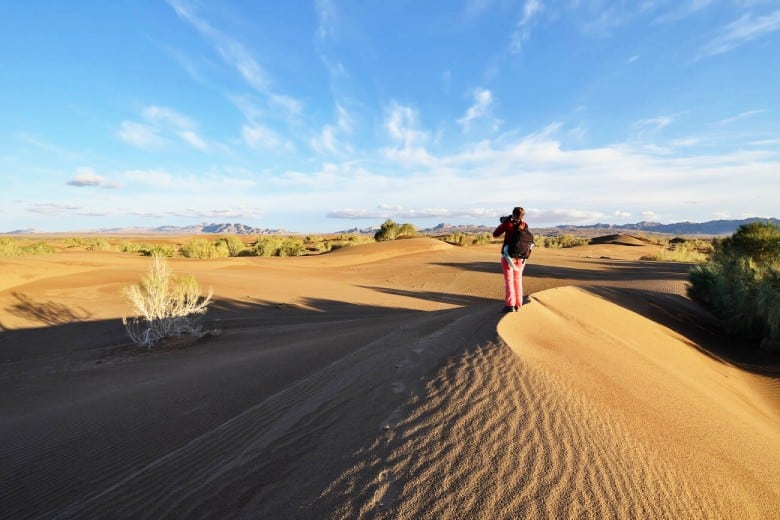
Mesr Desert, situated in Iran’s Isfahan Province, is a landscape straight out of a dream. This enchanting desert, known for its golden sand dunes and clear night skies, offers a tranquil escape into nature. The name ‘Mesr’ is aptly derived from the Persian word for Egypt, reflecting the desert’s immense and mysterious beauty.
The desert’s vast expanses of sand dunes, which shift and ripple with the wind, create a dynamic and ever-changing landscape. It’s an ideal location for sandboarding, camel riding, and star gazing. The lack of light pollution makes the Mesr Desert a perfect spot for astronomy enthusiasts to observe the stars in their full glory.
FUN FACT: Mesr Desert is not only a natural wonder but also a cultural experience, as it’s located near traditional Iranian villages where visitors can experience local hospitality and culture.
KNOW BEFORE YOU GO: The desert is best accessed from the city of Naein or Khur. Due to its remote location, it is recommended to visit with a tour guide or as part of an organized tour.
WHEN TO VISIT: The ideal time to visit the Mesr Desert is from late autumn to early spring, when the weather is cooler and more suitable for desert activities.
GATEWAY CITY: Naein or Khur
17. Margoon Waterfall

Margoon Waterfall, located in the scenic Fars Province of Iran, is a breathtaking natural spectacle and one of the country’s most magnificent waterfalls. Cascading from a height of approximately 70 meters and spanning over 100 meters in width, Margoon creates a stunning visual display as water flows over a series of rocky terraces.
This impressive waterfall, set against the backdrop of the Zagros Mountains, is known for its lush surroundings and the fine mist it generates, which creates a refreshing and ethereal atmosphere. The area around Margoon is a thriving habitat for a variety of plant and animal species, adding to the site’s ecological significance.
FUN FACT: Margoon Waterfall is unique because of its wide and curtain-like appearance, giving it the look of a thousand springs flowing down the mountainside.
KNOW BEFORE YOU GO: The waterfall is accessible from the city of Yasuj. A short hike is required to reach the waterfall, so it’s advisable to wear comfortable walking shoes.
WHEN TO VISIT: The best time to visit Margoon Waterfall is in the spring and early summer when the water flow is at its peak and the surrounding nature is lush and green.
GATEWAY CITY: Yasuj
18. Torkaman Sahra
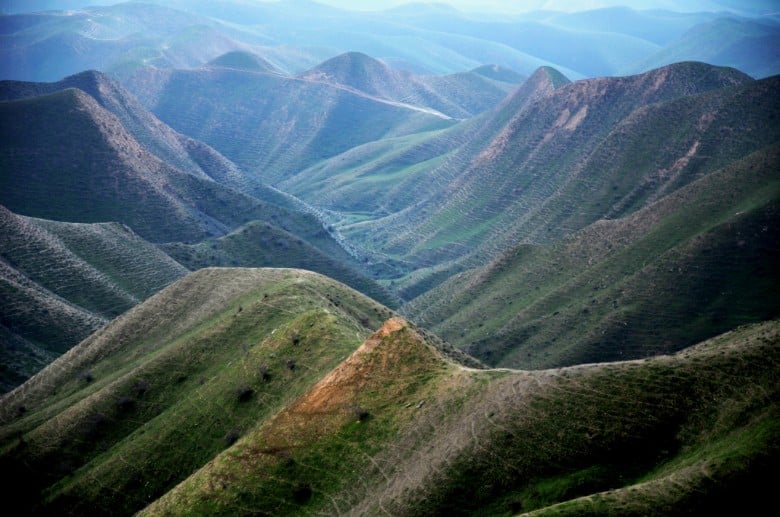
Torkaman Sahra, situated in the northern Golestan Province of Iran, is a captivating and lesser-known destination that offers a unique blend of cultural and natural beauty. This expansive area, known for its rolling hills, lush pastures, and the Caspian Sea’s nearby coast, is a significant part of the Turkmen Sahra region, home to the Turkmen people of Iran.
The region is celebrated for its rich Turkmen culture, evident in the vibrant traditional clothing, unique handicrafts, and the famous Turkmen horses. The landscape of Torkaman Sahra is a mix of steppe and forest, providing a habitat for diverse flora and fauna. It’s also known for its traditional yurts, where visitors can experience the nomadic lifestyle of the Turkmen people.
FUN FACT: Torkaman Sahra is renowned for its horse-breeding, especially the Akhal-Teke breed, known for their speed, endurance, and distinct metallic sheen.
KNOW BEFORE YOU GO: The region is accessible from the city of Gorgan. It’s recommended to explore Torkaman Sahra with a local guide to fully experience the Turkmen culture and navigate the landscape.
WHEN TO VISIT: The best time to visit Torkaman Sahra is from late spring to early autumn, when the weather is pleasant and the natural scenery is most vibrant.
GATEWAY CITY: Gorgan
19. Hengam Island

Hengam Island, located off the southern coast of Iran in the Hormozgan Province, is a hidden gem in the Persian Gulf. This small but picturesque island is known for its tranquil beaches, vibrant marine life, and friendly local community. Hengam’s unspoiled natural beauty makes it a perfect getaway for those seeking peace and an authentic island experience.
The island’s clear waters are ideal for snorkeling and swimming, offering a chance to observe a variety of marine species, including colorful fish and sometimes even dolphins. The local market on Hengam Island is famous for its handcrafted goods and fresh seafood, providing a glimpse into the island’s culture and lifestyle.
FUN FACT: Hengam Island is renowned for its glowing waters at night, a natural phenomenon caused by bioluminescent plankton that light up the shoreline.
KNOW BEFORE YOU GO: Hengam Island is accessible by boat from Qeshm Island. There are no cars on the island, so transportation is mainly by foot or bike, adding to its serene charm.
WHEN TO VISIT: The best time to visit Hengam Island is from late autumn to early spring, when the weather is mild and pleasant for beach activities and exploration.
GATEWAY CITY: Qeshm
20. Kavir National Park
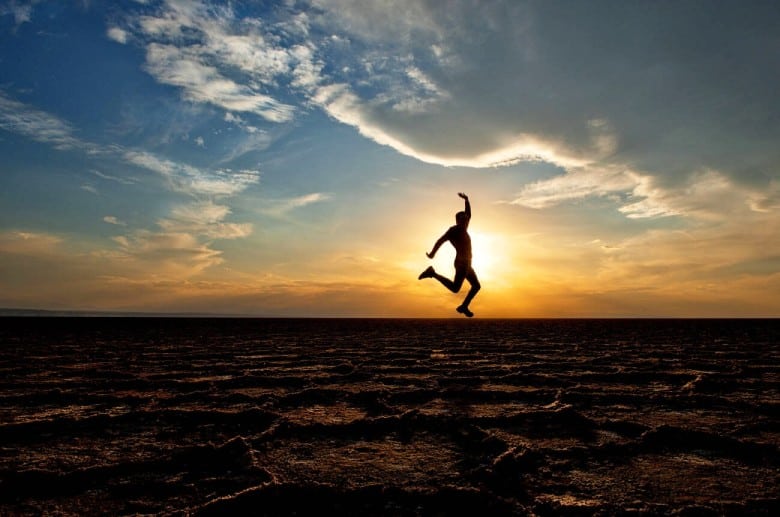
Kavir National Park, nestled in the Semnan Province of Iran, is a remarkable showcase of the country’s diverse ecosystems. Known as the ‘Little Africa‘ of Iran, this national park covers an area of over 4,000 square kilometers and offers a stunning array of landscapes, from salt flats and sand dunes to rocky outcrops and steppe areas.
The park is a haven for wildlife enthusiasts, as it hosts a variety of animal species, including the Persian cheetah, Persian leopard, Persian onager, and many migratory birds. The diversity of fauna and flora, coupled with the unique geological formations, makes Kavir National Park a fascinating destination for nature lovers and photographers.
FUN FACT: Kavir National Park is renowned for its starry nights. The clear skies and minimal light pollution make it an ideal spot for stargazing and astrophotography.
KNOW BEFORE YOU GO: The park is accessible from Tehran and Garmsar. Visitors are advised to explore with a guide, as the park’s terrain can be challenging and requires proper navigation.
WHEN TO VISIT: The best time to visit Kavir National Park is in the cooler months, from late autumn to early spring, when the wildlife is more active, and the temperatures are more comfortable for exploration.
GATEWAY CITY: Tehran or Garmsar
Final Words
As we conclude our journey through the 20 truly amazing natural wonders of Iran, it’s evident that this country holds some of the most stunning and diverse landscapes in the world. From the towering peaks of Mount Damavand to the serene beauty of the Persian Gulf’s islands, each location offers a unique glimpse into the natural majesty of Iran.
This exploration serves as more than just a travel guide; it’s an invitation to witness the untold stories of nature’s artistry. Iran’s natural wonders are not just destinations; they are experiences that resonate with the soul of every traveler.
SURFIRAN Tours
Best Iran Tours
We hope this list inspires you to see these wonders firsthand and discover even more of what Iran has to offer. For detailed guides on each destination and assistance in planning your perfect Iranian adventure, visit SURFIRAN for tailor-made tours and OrientTrips for your travel needs.
Remember, every journey starts with a single step. May your next step lead you to the unforgettable landscapes and enduring beauty of Iran.
Read More



